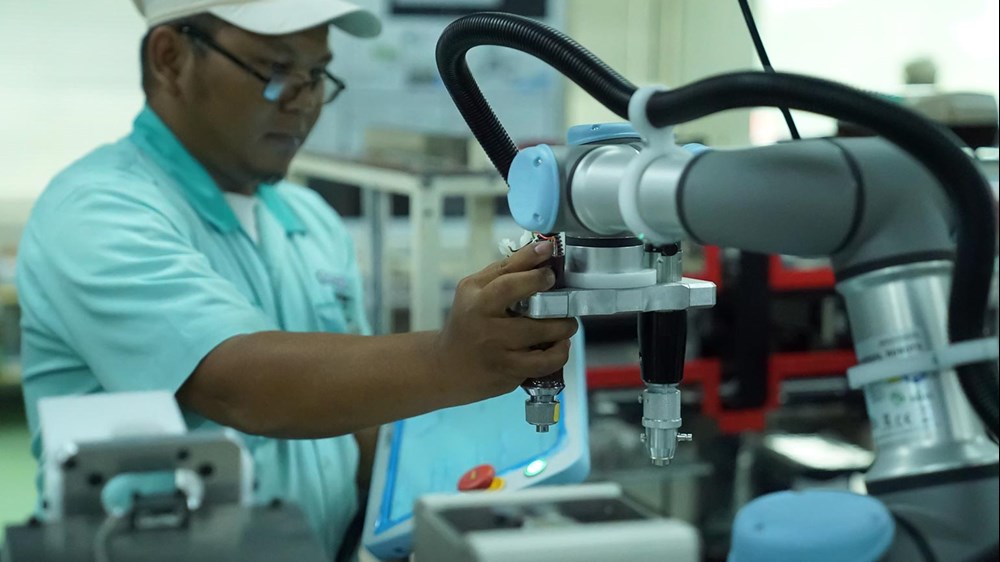This is from a series of blog posts exploring the many ways in which cobots support adaptation and business continuity in uncertain times. Each post focuses on a popular application for UR cobots and shows how cobots enable flexible, future-proofed automation deployments for companies of all sizes.
Achieving consistent, high quality results on repetitive screw driving, nut running and insertion tasks is a complex challenge for human workers. Frequently, these tasks involve multiple positions, directions and heights, and require variation in the torques delivered to the screws or nuts. Additionally, these jobs are repetitive and unergonomic, particularly when workers are asked to handle bulky and heavy tools to drive screws and nuts during the production process.
Using collaborative robots –or ‘cobots’– to automate your screw and nut driving tasks, provides several benefits. Cobots can reposition their tools more quickly and accurately than human workers, which means an increase in both production and quality. Advances in force-sensing allow cobots to ‘feel’ when tightening is complete, eliminating the problem of over application of torque, which happens all too often when screw driving tasks are manually performed. Furthermore, automating mundane assembly jobs through collaborative automation ensures a better environment for existing workers who are freed from unergonomic, repetitive strain injury-causing jobs and can be reassigned to more value-added tasks.
The versatility of UR cobots is a valuable quality at any time because it enables manufacturers to quickly adapt to different circumstances. But in times of global uncertainty like these, the knowledge that your automation investment can be redeployed on a wide range of possible applications provides a rare sense of reassurance.
For example, an ageing workforce and the need to reduce both takt time and relief worker costs prompted auto making giant Nissan to deploy two lines of UR10 cobots in its stunning Yokohama manufacturing facility. Intended to assist with assembly tasks, the cobots were first assigned to loosen bolts on cylinder head cam brackets. Leveraging the versatility of our cobots, the UR10s were then redeployed to assist with the process of installing engine block intake manifolds, which meant working in close collaboration with human workers. “By being able to move the UR robot to any place we see takt time overruns, we are thinking about creating production equipment capable of flexibly responding to the situation,” said Subsection Chief of Engine Section at Nissan, Mr Onishi.
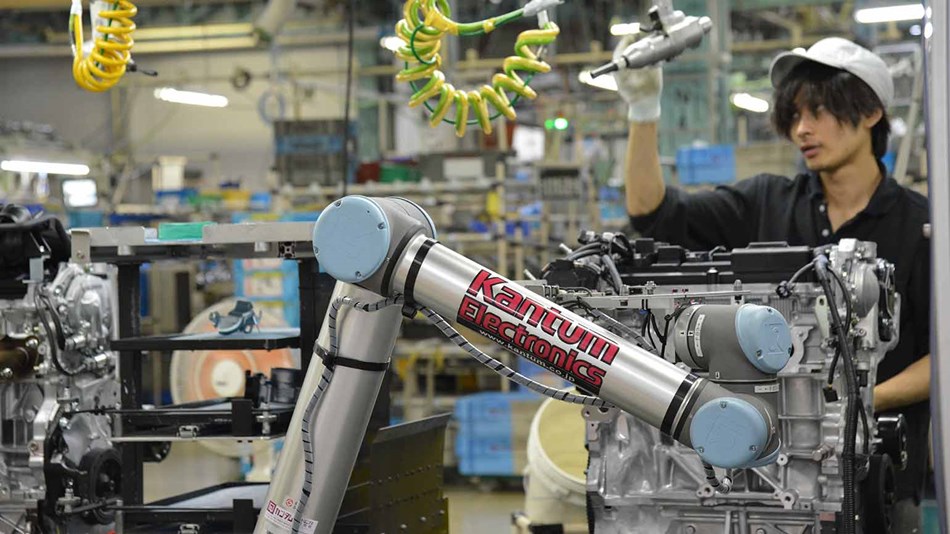
Nissan deployed UR10 cobots in a range of assembly tasks, including tasks that involve close collaboration with humans.
Meanwhile, PT JVC Kenwood Electronics Indonesia (JEIN), a leading manufacturer of car audio visual and navigation products with a monthly production volume of about 400,000 pieces, deployed seven UR3 cobots to increase productivity and product quality, while reducing operational costs and improving worker safety. Demonstrating the adaptability of our collaborative automation solutions, JEIN customized their cobots to perform three crucial tasks at the facility – screw driving, soldering and pick and place. And following the successful adoption of Universal Robots at JEIN, the JVC Kenwood Group is now looking to adopt UR cobots at its operations in Japan, China, Malaysia and Thailand.
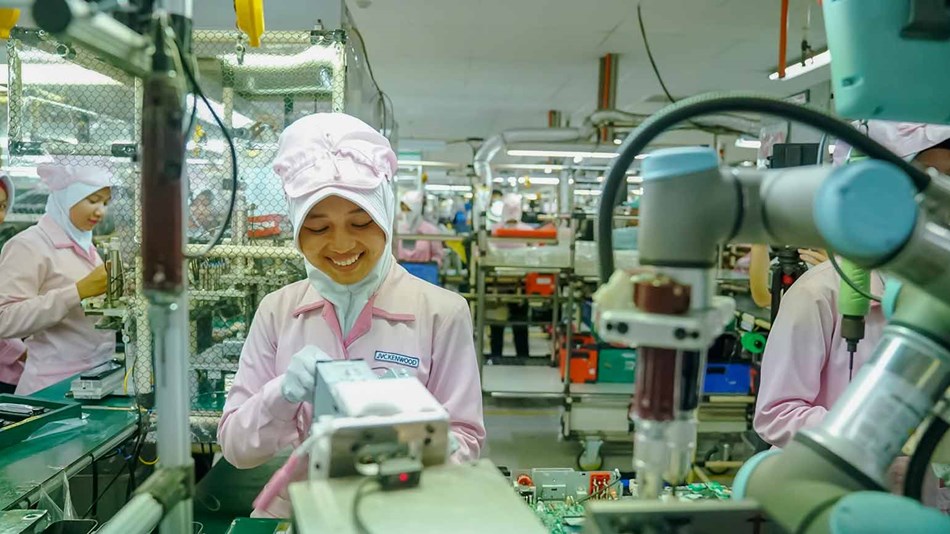
The safety features of Universal Robots’ cobots was a big factor driving their adoption at JEIN. Here, a UR3 is shown working in close proximity to a human worker without the need for guarding or fencing.
The UR+ ecosystem contains numerous UR+ Application Kits and components designed to meet all your assembly application requirements, from screw driving and nut driving to insertion. Manufacturers struggling to fill open positions and those dealing with absenteeism due to today’s challenging, COVID-19 impacted labor market will find assembly automation solutions in UR+ that can fill those gaps in your workforce. And with social distancing requirements causing serious disruption to assembly lines, manufacturers will discover automation that is easy and safe to deploy beside humans on production lines without the need for safety fencing.
For example, SPATZ is an automated screw driving system with automatic tool change and automatic feeding of fasteners. The system integrates no less than seven UR+ components providing automatic tool change and feed unit of fasteners through a Pick&Place system.
The system is easily programmed through the URCap a software handshake that provides full integration with Universal Robots’ easy to use teach pendant. Thanks to its modular design, which enables the use of different types of screw driving tools and grippers, SPATZ can handle fasteners of different geometries and a wide range of screw driving applications. Since the systems only needs to be taught a few respective positions before being deployed, programming motion sequences is both quick and easy. An internal supply unit is included as standard, but if space is limited, an external supply unit can also be used.
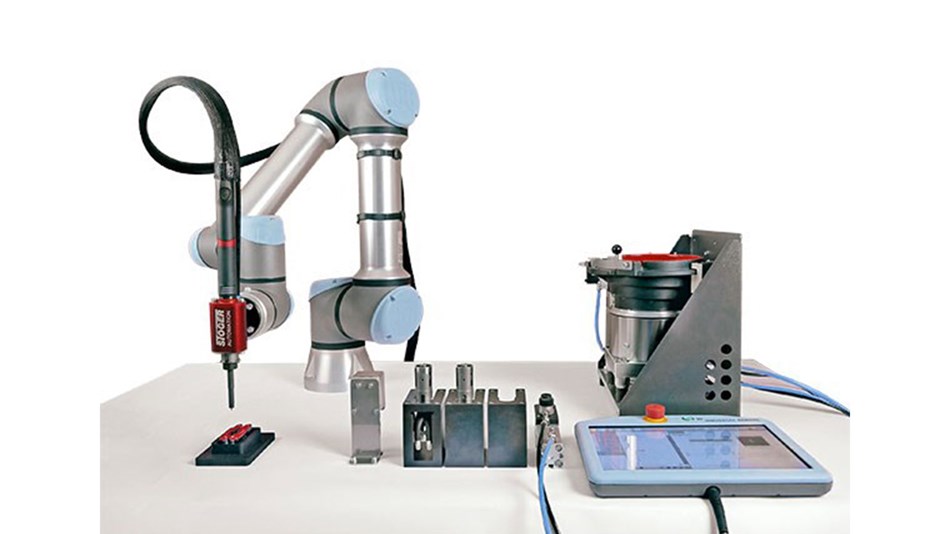
The versatile SPATZ system allows multiple work steps to be performed by one low cost, easy to use cobot.
Another ingenious assembly-related product available through the UR+ ecosystem is Visumatic’s VCM-3X.2 cobot fastening system, which is a complete feed and drive package built to bring advanced assembly capabilities to collaborative work spaces. Set up is easy thanks to the included URCap plugin, which provides complete integration with our intuitive teach pendant. The VCM-3X.2 has a payload of 2.25 kg (4.96 lb) and arrives with all the hardware, software and sensors necessary to get started on your fastening applications, including a direct faceplate mount for easy installation, a URCap Plugin on USB drive and a fastener delivery confirmation sensor.
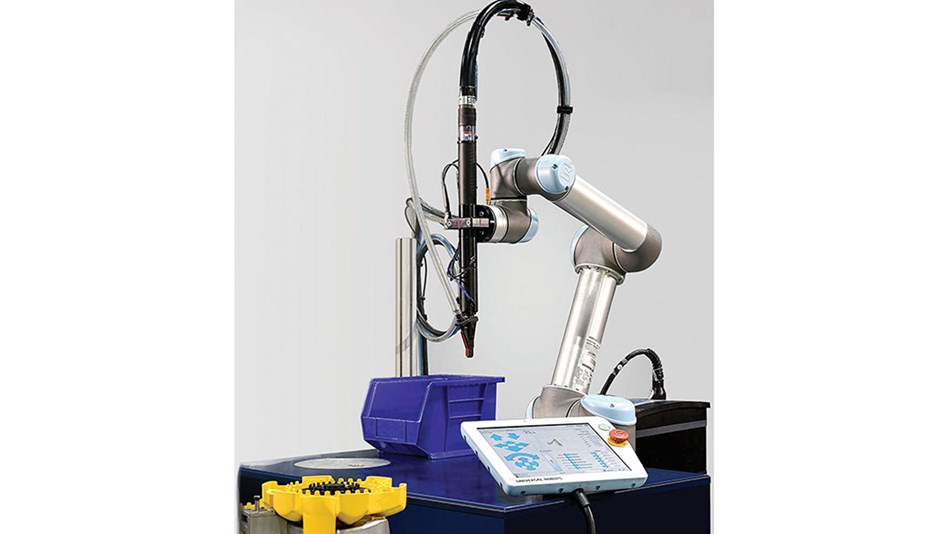
The VCM-3X.2 comes with a connected screw feeder system that delivers each screw on demand and sends it to the drive spindle for a repeatable fastening operation.
There’s no doubt that manufacturers are facing unprecedented levels of uncertainty due to the spread of COVID-19. The pandemic, the accompanying restrictions and social distancing requirements and labor shortages are a real challenge to business continuity. Cobots from Universal Robots offer the flexibility, safety, ease of use and small footprint that you need to adapt and survive in these unpredictable times. And, unlike traditional automation, you can deploy our robots without breaking the bank thanks to Universal Robots’ rental and leasing services , allowing you to quickly adopt and deploy automation at low cost.
Interested in finding out more about how Universal Robots can help with your assembly applications? Contact one of our experts here!
JIM LAWTON
Experienced in both start-up and Fortune 500 environments, Jim’s career has focused on building organizations that give manufacturers new and effective ways to capitalize on the intersection of technology and business performance. From early days in e-commerce market and supply chain optimization to supplier risk management, Jim has been on the leading edge of innovation that changes what world-class manufacturing looks like. Since 2013, Jim has focused on the opportunity for manufacturers to harness advanced automation and collaborative robots to transform their operations and how the world thinks about work. He joined Universal Robots in 2018 and today leads the product and applications management of the company’s advanced collaborative robots to manufacturers and distributors all over the world. Jim holds a BS in Electrical Engineering from Tufts University, an MS in Electrical Engineering and Computer Science from MIT and an MBA from MIT’s Sloan School of Management, where he was an inaugural Fellow in the MIT Leaders for Global Operations (LGO) program.


